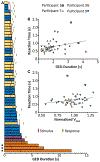Realistic driving simulation during generalized epileptiform discharges to identify electroencephalographic features related to motor vehicle safety: Feasibility and pilot study
- PMID: 31646628
- PMCID: PMC7424790
- DOI: 10.1111/epi.16356
Realistic driving simulation during generalized epileptiform discharges to identify electroencephalographic features related to motor vehicle safety: Feasibility and pilot study
Abstract
Objective: Generalized epileptiform discharges (GEDs) can occur during seizures or without obvious clinical accompaniment. Motor vehicle driving risk during apparently subclinical GEDs is uncertain. Our goals were to develop a feasible, realistic test to evaluate driving safety during GEDs, and to begin evaluating electroencephalographic (EEG) features in relation to driving safety.
Methods: Subjects were aged ≥15 years with generalized epilepsy, GEDs on EEG, and no clinical seizures. Using a high-fidelity driving simulator (miniSim) with simultaneous EEG, a red oval visual stimulus was presented every 5 minutes for baseline testing, and with each GED. Participants were instructed to pull over as quickly and safely as possible with each stimulus. We analyzed driving and EEG signals during GEDs.
Results: Nine subjects were tested, and five experienced 88 GEDs total with mean duration 2.31 ± 1.89 (SD) seconds. Of these five subjects, three responded appropriately to all stimuli, one failed to respond to 75% of stimuli, and one stopped driving immediately during GEDs. GEDs with no response to stimuli were significantly longer than those with appropriate responses (8.47 ± 3.10 vs 1.85 ± 0.69 seconds, P < .001). Reaction times to stimuli during GEDs were significantly correlated with GED duration (r = 0.30, P = .04). In addition, EEG amplitude was greater for GEDs with no response to stimuli than GEDs with responses, both for overall root mean square voltage amplitude (66.14 μV vs 52.99 μV, P = .02) and for fractional power changes in the frequency range of waves (P < .05) and spikes (P < .001).
Significance: High-fidelity driving simulation is feasible for investigating driving behavior during GEDs. GEDs with longer duration and greater EEG amplitude showed more driving impairment. Future work with a large sample size may ultimately enable classification of GED EEG features to predict individual driving risk.
Keywords: EEG; absence seizures; consciousness; driving; epilepsy; spike-wave discharges.
Wiley Periodicals, Inc. © 2019 International League Against Epilepsy.
Conflict of interest statement
CONFLICT OF INTEREST
None of the authors has any conflict of interest to disclose. We confirm that we have read the Journal’s position on issues involved in ethical publication and affirm that this report is consistent with those guidelines.
Figures




References
-
- Gil-Nagel A, Abou-Khalil B. Electroencephalography and video-electroencephalography. Handb Clin Neurol. 2012;107:323–45. - PubMed
-
- Blumenfeld H. Cellular and network mechanisms of spike-wave seizures. Epilepsia. 2005;46:21–33. - PubMed
-
- Avoli M, Biagini G. Thalamocortical synchronization and absence epilepsy In: Schwartzkroin P, editor. Encyclopedia of Basic Epilepsy Research. Cambridge, MA: Academic Press, 2009; p. 28–36.
Publication types
MeSH terms
Grants and funding
LinkOut - more resources
Full Text Sources
Medical

